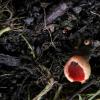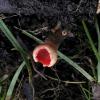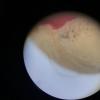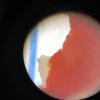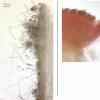
21-12-2025 09:32
Hello.A tiny ascomycete found embedded in wood in

21-12-2025 21:32
Pol DebaenstHello, Garden, Burgweg 19, Veurne, BelgiumOn 10/1

22-12-2025 23:38
Patrice TANCHAUDBonsoir, récolte sur un mur en pierre, apothéci

22-12-2025 00:47
Patrice TANCHAUDBonsoir, récolte à proximité du milieu dunaire

21-12-2025 21:40
Isabelle CharissouBonjour, j'aimerais connaitre les références de

20-12-2025 23:08
Patrice TANCHAUDBonsoir, récolte sur sol sablonneux dans l'arri�
Sarcoscypha coccinea or austriaca
B Shelbourne,
23-01-2024 15:40
No spores ejected after several hours in a damp container, and I couldn't find many mature and vital asci or spores in two sections. I tried to use Spooner's key to Sarcoscypha and Sarcosomataceae in Britain (2002).
Habitat: Buried deciduous twig, muddy area with leaf litter, grass around, near Salix and Alnus, streams nearby flooding area in heavy rain.
Key characters: Hairs sinuous but not convoluted, paraphyses not moniliform below (one maybe), spores narrower and more rounded at the poles.
Vital spores measured in asci (some seem too narrow to be fully mature):
(17.1) 20.4 - 21.4 (21.8) × (7.8) 7.84 - 9.4 (11.6) µm, Q = (1.9) 2.2 - 2.5 (2.7), N = 7, Me = 20.5 × 9 µm ; Qe = 2.3.
Peter Thompson,
23-01-2024 15:51
Re : Sarcoscypha coccinea or austriaca
The fruit bodies are too immature.
The best month for collecting Sarcoscypha in Britain is February, so perhaps revisit the site in two to three weeks.
S. austriaca is far more common than S. coccinea in Britain.
B. Spooner made mistakes with Sarcoscypha taxonomy, among other things. Best to consult more up to date data sources.
With Best Wishes,
Peter.
Hans-Otto Baral,
23-01-2024 16:35

Re : Sarcoscypha coccinea or austriaca
From the curled hairs I suspect S. austriaca which has a later phylogeny than S. coccinea, i.e. mainly March-April.
B Shelbourne,
23-01-2024 17:24
Re : Sarcoscypha coccinea or austriaca
Thank you both for your comments, I will look for more mature ascomata and an updated key.
Michel Hairaud,
23-01-2024 18:38

Re : Sarcoscypha coccinea or austriaca
Hi Ben and everyone, I agree with Zotto's diagnostic with the appearance of the hairs
I wanted also to add that in Brittany S austriaca is , as in Great Britain, the most common (and often the sole) species is austriaca , mostly on SAlix .
The only areas where coccinea can be found are small calacareous limited places
AmitiésMichel
I wanted also to add that in Brittany S austriaca is , as in Great Britain, the most common (and often the sole) species is austriaca , mostly on SAlix .
The only areas where coccinea can be found are small calacareous limited places
AmitiésMichel
B Shelbourne,
23-01-2024 19:21
Re : Sarcoscypha coccinea or austriaca
Thank you Michel, that is helpful information.
It would seem these are most likely to be immature ascomata of S. austriaca then, given the hairs and habitat. Hopefully I will have a chance to examine some more soon.
It would seem these are most likely to be immature ascomata of S. austriaca then, given the hairs and habitat. Hopefully I will have a chance to examine some more soon.
